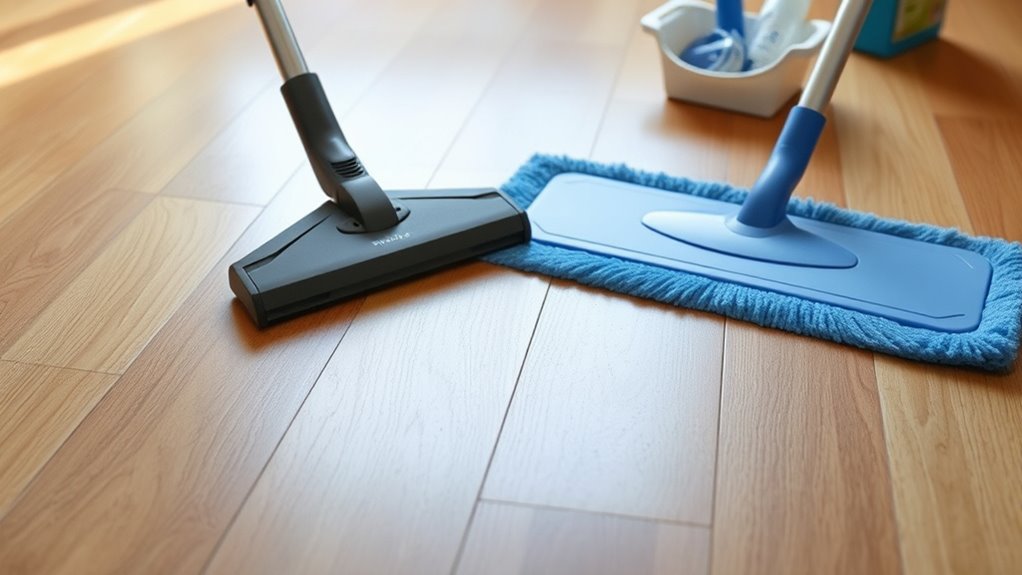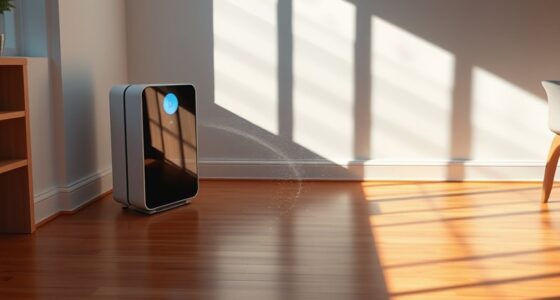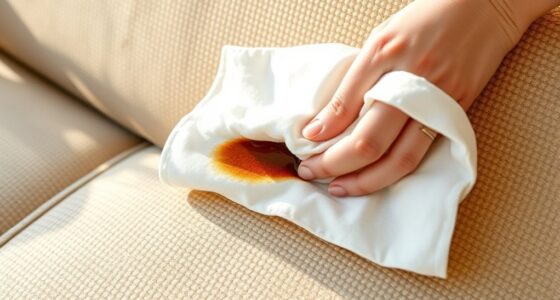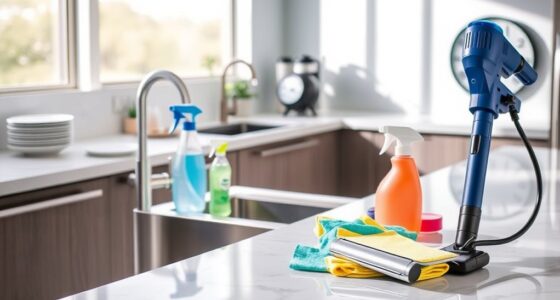To keep your floors clean and lasting longer, vacuum regularly using suitable settings for your flooring type to remove loose dirt and debris. Use a damp microfiber mop with eco-friendly cleaners to break down sticky residues without damaging delicate surfaces like hardwood or laminate. For durable floors like tile or vinyl, more vigorous cleaning works well. Proper maintenance involves consistent vacuuming, gentle mopping, and choosing the right eco-friendly products—keep going to discover tips tailored to your floor type.
Key Takeaways
- Regular vacuuming removes loose dirt and debris, preventing surface scratches and maintaining floor cleanliness.
- Use appropriate vacuum settings and attachments for your flooring type to avoid damage.
- Damp mop with eco-friendly solutions to effectively clean without harming delicate floors.
- Choose microfiber or soft sponges for mopping to prevent scratches on hardwood and laminate surfaces.
- Consistent cleaning and proper maintenance prolong floor lifespan and preserve their appearance over time.

Have you ever wondered how to keep your floors looking spotless and well-maintained? The secret lies in understanding your flooring material choices and selecting the right cleaning methods. Different floors require specific care, so knowing whether you have hardwood, tile, laminate, or vinyl helps you choose the most effective cleaning routines. For instance, hardwood floors benefit from gentle cleaning to prevent scratches, while tile and vinyl are more forgiving and can handle more robust cleaning methods. When it comes to maintaining your floors, using eco-friendly cleaning products is a smart move. These products are not only better for the environment but also safer for your family and pets, reducing exposure to harsh chemicals that can damage your flooring over time.
Choosing eco-friendly cleaning products makes a significant difference in how well your floors stay in top shape. Many conventional cleaners contain chemicals that can dull finishes or cause discoloration, especially on sensitive flooring materials like hardwood or laminate. Instead, opt for natural solutions like vinegar and water, or commercial eco-friendly cleaners designed specifically for your type of flooring. These options effectively remove dirt and grime without risking damage or leaving behind harmful residues. Incorporating such products into your routine ensures a cleaner, healthier home while prolonging the life of your floors.
Using eco-friendly cleaners protects your floors and prolongs their beauty naturally.
Vacuuming is your first line of defense for maintaining a pristine surface. Regularly vacuum your floors to pick up loose dirt, dust, pet hair, and debris. Use a vacuum with adjustable settings or a brush attachment suitable for your flooring type. For hardwood and laminate, a soft brush or setting reduces the risk of scratching. For tile and vinyl, you can use a more vigorous setting. Consistent vacuuming prevents particles from scratching or dulling the surface and keeps your floors looking fresh. It’s best to vacuum at least once a week, or more often if you have pets or high traffic areas.
Mopping is the next step in deep cleaning your floors, and choosing the right mop and cleaning solution is vital. Use a microfiber mop or a soft sponge mop to avoid scratching delicate surfaces. When mopping, always opt for a damp mop rather than soaking the floor—excess water can damage certain flooring materials like hardwood. Mix your eco-friendly cleaning product with water according to the instructions, and avoid harsh chemicals. Mopping should be done regularly, especially in busy areas, to remove sticky residues, footprints, and stains. Be sure to rinse your mop frequently to prevent spreading dirt around, and dry the floor with a clean cloth if necessary to avoid streaks or water spots. Additionally, understanding your flooring material helps you select the best cleaning method and products for long-term care.
Maintaining your floors is about consistency and choosing the right products and techniques. With proper flooring material choices and eco-friendly cleaning products, your floors will stay beautiful longer, creating a healthier home environment. Regular vacuuming and careful mopping are simple yet effective ways to preserve their appearance and durability. Keep these practices in mind, and your floors will continue to impress for years to come.
Frequently Asked Questions
How Often Should I Replace My Vacuum Filters?
You should replace your vacuum filters every 3 to 6 months to maintain ideal dust collection efficiency. Regular vacuum filter replacement prevents dirt buildup, guarantees your vacuum runs smoothly, and extends its lifespan. If you have pets or allergies, consider changing filters more often. Check your vacuum’s manual for specific recommendations, but don’t wait too long—consistent filter updates keep your vacuum performing at its best.
What Type of Mop Is Best for Hardwood Floors?
Imagine you’re cleaning your hardwood floors and want a safe, effective option. Microfiber mops are ideal because they gently lift dirt without scratching. Steam mops are also great, using heat to sanitize without harsh chemicals. Both options are better than traditional string mops, which can leave excess moisture. Choose a microfiber mop for regular cleaning or a steam mop for deep sanitizing, ensuring your hardwood stays beautiful and protected.
Can Certain Cleaning Agents Damage My Floor Type?
Yes, certain cleaning agents can damage your hardwood floors if they’re not compatible with your floor’s finish. Always check cleaning agent compatibility to avoid stripping or dulling the finish. Use gentle, pH-neutral cleaners designed for hardwood, and steer clear of harsh chemicals like bleach or ammonia. When in doubt, test a small area first to verify floor finish safety, helping your floors stay beautiful and protected over time.
How Do I Remove Stubborn Stains From Tiles?
To remove stubborn stains from tiles, start with a tile cleaning solution suitable for your surface. Apply it directly to the stain and let it sit for a few minutes. Use a soft-bristled brush or non-abrasive scrub pad to gently scrub the area. For tough stains, consider stain removal techniques like baking soda paste or a mix of vinegar and water. Rinse thoroughly and dry with a clean cloth for best results.
What Is the Lifespan of a Typical Floor Mop?
A typical floor mop’s lifespan depends on its material, but you can generally expect about 6 months to a year of effective use. A microfiber or cotton mop usually lasts longer, around 8-12 months, if you wash and store it properly. Synthetic or cheaper mops might wear out sooner. To maximize your mop’s lifespan, rinse it thoroughly after each use and allow it to dry completely.
Conclusion
So there you have it—your floors’ new best friends: vacuum, mop, and a sprinkle of maintenance magic. Ignore them at your peril; after all, nobody wants to live in a palace of dust and grime. With just a little effort, you’ll turn your home into a sparkling sanctuary, or at least a place where dust bunnies fear to tread. Happy cleaning—your floors will thank you, even if they never say it!









